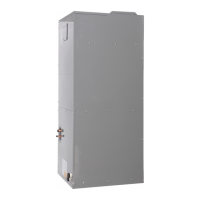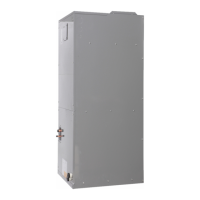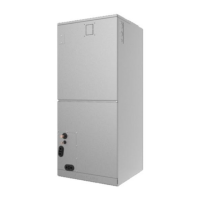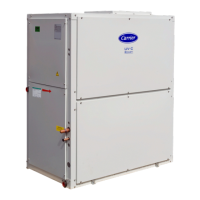40MBAB: Installation Instructions
Manufacturer reserves the right to change, at any time, specifications and designs without notice and without obligations.
28
24V Interface Board
Remote control (ON-OFF) terminal port CN2 and jumper
JR1 – OUTPUT 12VDC:
• Remove the jumper JR1 to enable the ON-OFF function
• When the remote switch is off (OPEN); the unit is OFF
• When remote switch is on (CLOSE); the unit is ON
• When the remote switch is close/open, the unit responds to the demand
within 2 seconds
• When the remote switch is on, you can use the included remote
controller or wired controller to operate the unit as normal. When the
remote switch off, the unit would not respond the command from the
remote controller or wired controller and a CP code would be displayed
on the board.
• The voltage of the port is 12V DC, design Max. current is 5mA.
Fig. 63 —Remote Control Terminal Port CN2 and
Jumper JR1
Control Logic
Table 18 — Indoor Unit Connector
LED Display
The control displays active faults switches on the LED display. If the
control displays the fault switch and the LED flashes quickly, the unit has
malfunctioned. Refer to the detailed fault switches.
TEST RUN
BEFORE THE TEST RUN
A test run must be performed after the entire system has been completely
installed. Confirm the following points before performing the test.
a. Indoor and outdoor units are properly installed.
b. Piping and wiring are properly connected.
c. There are no obstacles near the unit’s inlet and outlet that
might cause poor performance or product malfunction.
d. Refrigeration system does not leak.
e. Drainage system is unimpeded and draining to a safe location.
f. Heating insulation is properly installed.
g. Grounding wires are properly connected.
h. Length of the piping and additional refrigerant recorded.
i. Power voltage is the correct voltage for the system.
Test Run Instructions
1. Open both the liquid and gas stop valves.
2. Turn on the main power switch and allow the unit to warm up.
3. Set the air conditioner to the COOL mode.
4. For the indoor unit:
a. Double check to see if the room temperature is being registered
correctly.
b. Ensure the manual buttons on the indoor unit work properly.
c. Ensure the drainage system is unimpeded and draining
smoothly.
d. Ensure there is no vibration or abnormal noise during
operation.
5. For the outdoor unit:
a. Check to see if the refrigeration system is leaking.
b. Ensure there is no vibration or abnormal noise during
operation.
c. Ensure the wind, noise, and water generated by the unit do not
disturb neighbors or pose a safety hazard.
6. Drainage Test
a. Ensure the drainpipe flows smoothly. New buildings should
perform this test before finishing the ceiling.
b. Remove the test cover. Add 2,000 ml of water to the tank
through the attached tube.
c. Turn on the main power switch and run the air conditioner in
the COOL mode.
d. Check to see that the water is discharged. It may take up to one
minute before the unit begins to drain depending on the
drainpipe.
e. Ensure there are no leaks in any of the piping.
f. Stop the air conditioner. Turn off the main power switch and
reinstall the test cover.
NOTE: If the unit malfunctions or does not operate according to
your expectations, please refer to the Troubleshooting
section of the owner’s manual before calling customer
service.
Connector Purpose
R 24V
CCOM
GFAN
Y First stage cooling
Y Y2 Second stage cooling
B Heating (Four-way valve)
W Heating operation
W1 Electric Heating Operation 1
W2 Electric Heating Operation 2
E/AUX Emergency Heat / Auxiliary Heat
DH Dehumidification
L Error Signal
Failure to perform the test run may result in unit damage, property
damage, or personal injury.
CAUTION

